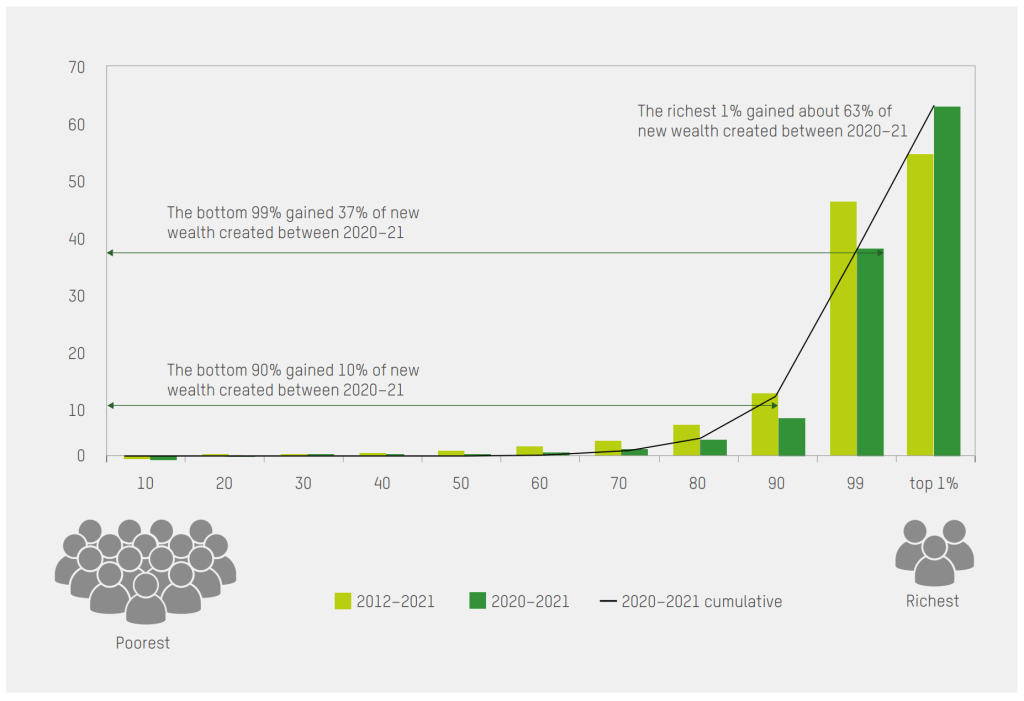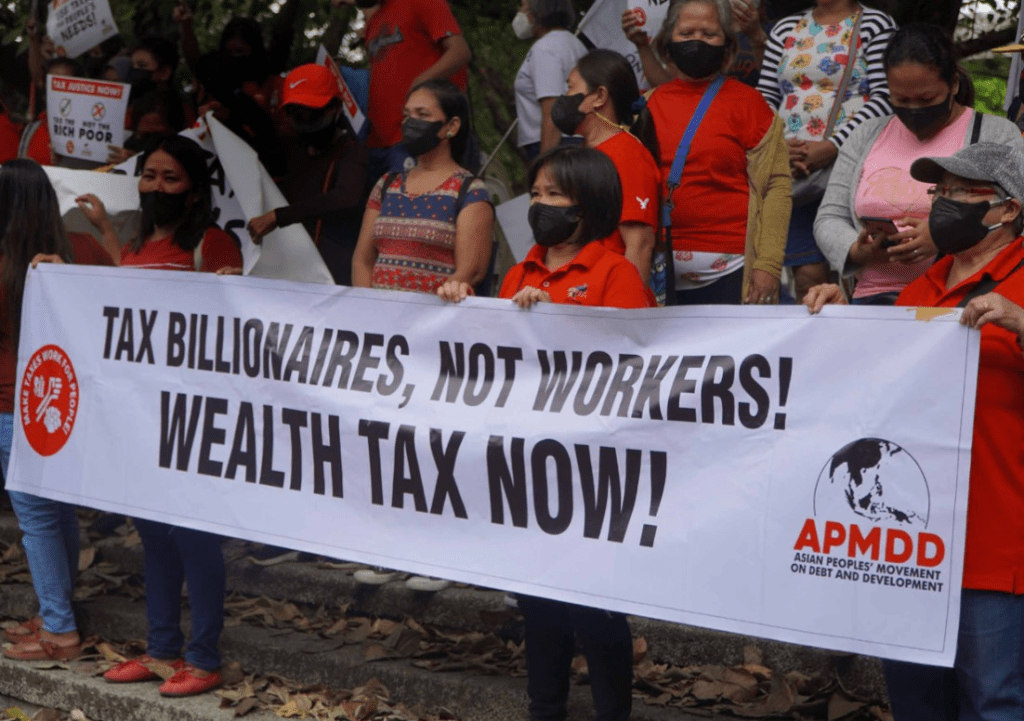In a world where the consequences of climate change are becoming increasingly apparent, the role of greenhouse gas (GHG) emissions has taken centre stage in global discussions on sustainability and environmental responsibility. Amidst the urgent need for collective action, critical examinations of the carbon footprint of various sectors has brought attention to a group of often overlooked contributors—the super-rich.
Climate change is an issue that affects all life on Earth. However, the extent to which the super-rich influence the emissions landscape is a subject of great concern. While the super-rich live lifestyles characterised by opulence and extravagance, many have come to question the ethics of their environmental impacts. From private jets and mega-yachts to sprawling estates, the choices made by the super-rich reverberate across the world. This then influences energy consumption patterns, resource utilisation, and, ultimately, the health of our planet.

Source: Binay Sinha – BS.
Who Are The Super-Rich And What’s Their Connection To GHG Emissions?
The richest one percent of humanity is responsible for more carbon emissions than the poorest 66 percent. This statistic should make it clear that the world is facing a conjoined crises of climate breakdown and runaway inequality. Over the past decades, a broad trend of rising income inequality has been emerging globally. In fact, Income inequality is on the rise in the majority of advanced and major emerging economies. These economies account for approximately two-thirds of the world’s population and 85 percent of global GDP. Reaping the rewards of this rise in inequality are the super-rich. This small group sits at the top of the economic tree, where they continue to enjoy disproportionate amounts of wealth.

Image source: Oxfam.
In recent years, billionaires have seen astronomical increases in their wealth. Amidst the COVID-19 pandemic and the subsequent cost-of-living crisis, the richest one percent captured 63 percent of all new wealth. The rest of the world collectively retained the remaining 37 percent. And for every $1 of new global wealth earned by someone in the bottom 90 percent, a billionaire gained roughly $1.7 million.
Billionaire fortunes have experienced a slight decline from their 2021 peak. However, they still surpass pre-pandemic levels by trillions of dollars. While the rich are raking in these absurd profits, at least 1.7 billion workers are living in countries where inflation is outpacing wages. Meanwhile, approximately one in ten people on earth (around 820 million) are going hungry. The World Bank says we are likely seeing the biggest increase in global inequality and poverty since WW2.
Emissions of the Super-Rich
The lavish lifestyles lived by the super-rich are accompanied by huge levels of GHG emissions. The scale of these emissions dwarf those produced by the rest of humanity. Private jets and super-yachts are just some of the materialistic possessions that drive up their direct emissions. Studies have shown that private air travel is the greatest contributor to climate pollution in terms of direct individual consumption. For example, the UK’s richest people produce more carbon emissions from air travel than the poorest do through every aspect of their day-to-day lives.

Source: Otto, et al., 2019.
The emissions from these extravagant and opulent lifestyles are already thousands of times greater than those of the average person. This inequality alone is completely unacceptable. However, it doesn’t stop there. Recent studies from Oxfam on the investments of 125 of the world’s richest individuals have shown that they are indirectly emitting 3 million tonnes of GHGs per year. This is more than a million times the average for someone in the bottom 90 percent of humanity.
Money in all the wrong places
Oxfam’s “Carbon Billionaires” report showed that emissions stemming directly from the lifestyles of the super-rich are indeed massive. However, these emissions are nothing compared to the indirect emissions resulting from their investments. The world’s wealthiest individuals’ investments account for up to 70 percent of their total emissions. This study also found that billionaires had about 14 percent of their investments in polluting industries such as fossil fuels. This percentage exceeds what one would expect from the average investor at least two times over. The Carbon Billionaires report, which analysed 125 of the world’s richest, found that only one billionaire in the entire sample had investments in a renewable energy company. Pumping large sums of money into high carbon infrastructure means we are signing up for decades of higher levels of emissions. Considering the urgency of the current climate crisis, this is not something we can afford to do.
The personal emissions of the super-rich have continued to rise since 1990. They have now reached a point where they are 77 times larger than a level that would be compatible with the goals of the Paris agreement. That key goal is limiting global average temperature increase to no more than 1.5°C above pre-industrial levels. The super-rich have the means to insulate themselves from the damage they cause. They can retreat to one of their many protected, luxurious, air-conditioned homes. Meanwhile, those on the front lines, who suffer due to the excesses of the wealthiest, find no refuge from the drought, flooding, and unyielding heat. We must find a way to massively reduce economic inequality and redistribute both wealth and power if we are to achieve our science-based targets and avert climate disaster.
moving towards a fairer world
“The rich and the powerful in our world fear the end of capitalism – their power and privilege – more than they fear the end of our beautiful, precious planet.”
(Njoki Njehu, Pan-Africa Regional Coordinator, Fight Inequality Alliance)
To move towards a fairer world, we must hold the super-rich accountable for the disproportionate amount of emissions they generate, both through personal consumption and their investments. We need to tax the wealthiest individuals and regulate their investments. We must steer them away from high-carbon and polluting investments that contribute to the destruction of our planet. In a recent study, Oxfam estimated that a wealth tax on the global super-rich could generate $1.4 trillion annually. These funds could be instrumental in aiding developing nations, particularly those severely affected by the climate crisis. The United Nations Environment Programme (UNEP) anticipates that adaptation costs for developing countries may reach $300 billion per year by 2030, with Africa alone requiring $600 billion from 2020 to 2030.
On top of fairer tax laws, governments must enforce stricter policies that require corporations to be more accountable and transparent in reporting their emissions. Incentives to encourage investments in green finance will also be beneficial. The major and growing role that the super-rich play in total emissions is seldom taken into account in the formulation of climate policies. It is now clear that we must reshape this perspective. Billionaire investors situated at the top of the corporate pyramid bear a huge responsibility for the alarming state of the environment. Their evasion of accountability has persisted for far too long and needs to be addressed.

Image source: Oxfam.
achieving the United Nations Sustainable Development Goals (SDGs) and how they link to GHG Emissions and the super-rich
The United Nations’ SDG 4 (Quality Education) and SDG 8 (Decent Work & Economic Growth) are directly linked to GHG emissions and the current level of accountability faced by the super-rich. A wealth-tax on the super-rich and stricter tax regulations for investments in polluting industries would generate a huge stream of funds that could be spent to ensure inclusive and equitable quality education and lifelong learning opportunities for those less fortunate. Additionally, funnelling money from these taxes into technological innovation and development of clean technologies will ensure economic growth oriented around sustainability.
A Thrivable Framework
For far too long, the wealthiest have gotten away with not being held to account for the emissions they produce. It is time for that to change. Wealth inequality and the climate crisis are undeniably linked. These issues must be tackled simultaneously if we hope to move towards a future in which all life can thrive.
The THRIVE Project stands to create a future in which humans will not only survive but also thrive. Our mission is dedicated to securing the enduring welfare and ‘thrivability’ of all species on Earth. The THRIVE Framework examines issues and evaluates potential solutions – making predictive analyses using topics that support environmental and social sustainability transformations. We recognise that human happiness can sometimes compete with environmental well-being. This is why we use our ciambella chart to illustrate the ‘thrivable zone’. THRIVE emphasises the possibility of satisfying environmental and social needs concurrently, without having to unfairly compromise.
If you would like to learn more about thrivability you can subscribe to our free newsletter. You can also check out our informative podcast series and watch some of our educational YouTube content. Additionally, come along to our regular webinar events to hear talks from experts in the field of thrivability.























